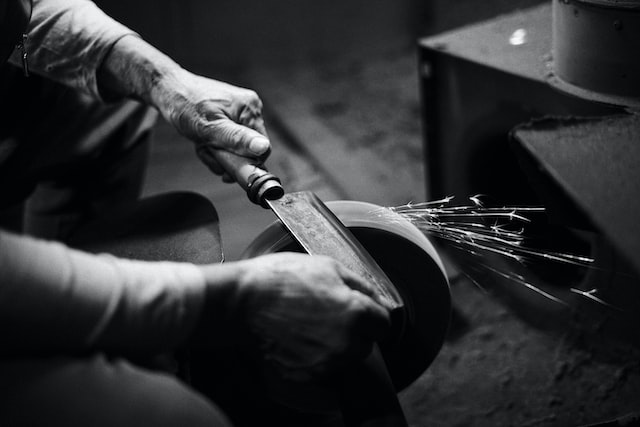A sharp kitchen knife can make all the difference when it comes to prepping food. Not only does it cut through ingredients more efficiently, but it also helps you cook faster. Maintaining your knives ensures they will hold an edge for extended periods of time so you don’t need to replace them as often.
How to Sharpen a Knife
Sharpening a blade requires two techniques: grinding or honing. Both methods are essential, but each produces a slightly different edge.
Grind: To sharpen a blade, place it against an abrasive surface (stone or ceramic) and grind it down with a tool such as a steel stone. Under pressure, the edges may bend just a bit too much and create a burr. This burr must be removed before honing the edge back to its true state.
Honing: To sharpen a blade, place it against a flat, smooth surface such as a whetstone or steel rod. Draw the knife along this surface at an angle of 20 degrees from tip to heel at one continuous motion. Repeat this motion five to ten times for sharper results.

Whetstone: When choosing a whetstone for sharpening your blade, it is essential to select one that is suitable for the blade type. While there are various types of whetstones available on the market, each has its own advantages and drawbacks.
Whatever your taste and budget, you can find a decent whetstone online for around $20. Some even come with a stone holder so that you can keep the stone steady while sharpening.
Position the knife and steel: With your non-knife hand, place the end of the metal rod against the blade at an approximate 15 to 20 degree angle. This angle doesn’t need to be exact; however, it is essential for keeping the blade away from the rod.

Begin honing: Place your dominant hand on the handle of the knife and angle it away from the rod at a 20-degree angle. Then, move your other hand forward and backward along the steel, sweeping both sides of the blade across at least three to four times. This will remove any remaining burrs or sharp edges on the blade.
Once complete, test the blade by pushing it against a piece of paper with only minimal pressure to see if it slices through without tearing. A dull knife will tear the paper while a sharp one should slice all the way through with only a few strokes.
Sharpening a knife may take some effort, but the results will be worth it in the end. Once your blade is razor-sharp, you’ll love using it in the kitchen! Just remember to clean it thoroughly after each use and store it securely for storage.





